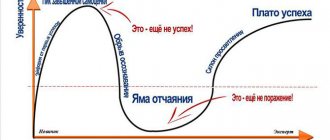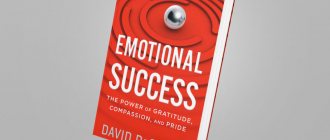Hello to all readers! Lyudmila is in touch. What events bring you an endless stream of joy, optimism and happiness? Think about it for a second. Wow, the corners of your mouth are probably already tugging at a smile. For me, joy is going out into nature with my family, seeing friends and much more. And this joy charges us for a large chunk of time. Today we have a pleasant topic - we are talking about positive emotions. I will give a complete list of them, and also tell you what influence they have on us. I don’t want to talk about bad things... Not today... But if you really want to balance your knowledge, you can delve into the list of negative emotions that I wrote earlier.
Positive and negative emotions
You might think that positive psychology is only about positive emotions. But it's not just them. Negative and neutral emotions are an integral component that we must feel in order to live brightly and richly. Why are negative emotions needed in combination with positive ones, and why a neutral state is an integral attribute of everyday life, read on.
Why is it good to be happy?
As you know, a positive emotional background is good for health. It helps improve the functioning of all organs and systems of the body, especially the nervous system. Positive emotions help to withstand stressful situations and avoid the occurrence of many diseases. Joy hormones (endorphins) contribute to the normalization of all biochemical processes in the body. Therefore, experiencing a lot of positive emotions is simply necessary for all people to maintain good health. It’s not for nothing that they say that laughter prolongs life.
A look from psychology
People have been studying emotions for years. Given the difficulty of focusing on feelings, it is not surprising that we know little about them. Most people lack an understanding of the necessity of both emotions for healthy functioning and a full range of feelings. Let's start with definitions and find out the types of feelings and impressions when certain emotions arise, what is their source and how to create them yourself.
Definition and meaning of positive emotions
Positive emotions are emotions that we generally find pleasant to experience. The Oxford Handbook of Positive Psychology defines them as “pleasant or desirable situational responses, distinct from pleasant feelings and undifferentiated positive affect.”
Essentially, this definition states that positive emotions are pleasant reactions to our environment (or our own internal dialogue) that are more complex and goal-directed than simple sensations.
Definition and meaning of negative emotions
On the other hand, negative emotions are those that we usually don't like. Negative emotions can be defined as “unpleasant or unhappy emotions that are evoked by people to express a negative impact on an event or person.”
If an emotion lowers your emotional state and worsens your mood, then most likely it is a negative emotion.
Learn more about conflicting feelings and cognitive dissonance.
Anisha L. Dillon: 3 Pairs of Feelings - Find Out Which Emotion You're Blocking
We are taught to “love your neighbor”, “turn the other cheek”, without completely understanding or taking into account the energy dynamics involved in this.
If you split the word "emotion" into two parts - "e" and "motion", you will see that it was originally formed from Latin roots meaning outward movement.
This definition fits well with the Reichian understanding of human emotions. At its core, emotion is nothing more than the movement of plasma, a wave of energy passing through the liquid contents of the body in an effort to express and release.
Such a detached point of view does not mean much to us when we are mourning a lost lover or angry at some offensive remark. But it certainly helps the Reichian therapist understand the mechanics of restoring healthy pulsation in the client's body to open the door to happiness, greater vitality and well-being.
Reich himself traced the emergence of emotions to their most primitive and basic form, choosing as an example a single-celled organism, the amoeba. Using a microscope, he saw that the plasma inside the amoeba cell was stretched towards the source of pleasure and retracted away from the source of pain.
This is a two-way movement, or, as Reich liked to call it, “the two-way emotion of protoplasm.”
The desire for pleasure causes movement from the cell nucleus to the periphery, while the desire to avoid pain causes movement in the opposite direction - compression from the periphery to the nucleus. Reich believed that this basic bidirectional pulsation is inherent in all living organisms and is the fundamental basis of human expression: we all want to feel pleasure; we all want to avoid pain. Reich also pointed out that movement, which is a means of expression, is an integral property of living organisms, distinguishing them from the rest of nature. To be alive means to move; to move means to express.
This all seems obvious, but it leads to a significant point: whether we like it or not, we are all emotional beings.
Feelings are part of the package called “life,” and the emotional expression of these feelings is a natural and necessary movement of our energy.
If we strangle them, suppress them, then we suppress the life force itself.
From this perspective, it is not difficult to observe the basic conflict that has arisen between human nature and our so-called socially acceptable behavior. In “advanced” societies, the less a person shows his emotions, the more civilized he is considered.
This reminds me of the famous British “pursed upper lip,” when not showing emotion in moments of extreme stress was considered the pinnacle of good manners and good manners.
I don't remember the title of the book, but I do remember that there was a quote from the diary of a British lady who found herself besieged in Lucknow during the Indian Mutiny in 1857. “Major So-and-So was decapitated by a cannonball while shaving this morning.” This was her entire diary: a pedantic listing of the horrors of the siege with harsh suppression of emotions.
We Americans aren't that good at hiding our emotions, but the general approach remains the same. For example, I remember how my sisters and I joked about how we all belonged to the Good family. And that our real last name is not Dillon, but Good, because whenever, when greeting each other, we asked each other: “How are you?”, the answer was always: “Good!”
It's the American way: look good, keep smiling and be confident that everything is great. And if some unwanted negative emotions begin to creep behind this facade with the inscription: “I’m fine,” then there is always the latest derivative of Prozac or Valium to neutralize them. Of course, these little smart pills, along with your suffering, will destroy your ability to be happy, but this is the price that most people are willing to pay for everything to continue to be nice and in order.
This position is characteristic not only of Americans and Europeans. All highly organized cultures, including Japan, China, Egypt and India, have always required strict formality in social interaction and generally prohibited the expression of feelings.
Reich's message to the world is that the process of civilization has gone too far in the direction of controlling emotions. There is a high price to pay for this - producing neurotic people who are unable to truly enjoy life.
This is especially true today. Thanks to the development of science, man has succeeded in creating a comfortable life. The world is filled with all sorts of technological wonders that make work easier and provide a variety of forms of leisure. But the parallel destruction of life force has almost deprived us of the ability to enjoy our own achievements.
We must restore our emotions to regain our love for life.
In pursuit of this goal, Charles Kelly took the basic Reichian pleasure-anxiety pulse and developed a more complex model for working with clients.
He discovered that it was more accurate and useful to think of emotions in terms of not one, but three “pairs of feelings.”
These are the three “pairs of feelings”:
- anger - love;
- fear - trust;
- pain is pleasure.
Each of the three negative emotions—anger, fear, and pain—is associated with a different aspect of the pulsation. Anger is associated with an outward movement, from the core to the periphery. Fear is associated with movement inward, from the periphery to the core. Pain is associated with a convulsive quality of energetic discharge, rapid contraction and subsequent relaxation of muscles. We feel it when we laugh, cry, experience an orgasm.
Each of the negative emotions, being blocked, is retained in the body in a characteristic way with the help of muscle tension. This allows an experienced therapist to “read” the client’s body and identify the predominant blocked emotion. To a certain extent, we can divide people into those who hold anger, those who hold fear, and those who hold pain.
This helps you decide where to begin the process of releasing trapped emotions and restoring a healthy pulse. Of course, this does not mean that only people who hold anger are angry. We all have a full range of emotions within us. This classification only indicates what kind of habit has formed in a person over many years and what type of emotions is mainly blocked.
The three positive emotions are also associated with pulsation. Love flows outward to other people from the core to the periphery. Trust is a form of receptivity that allows the outside world to penetrate within. Pleasure is a state of well-being that involves the entire body.
As we will see later, the fact that both negative and positive emotions are associated with pulsation has important implications because the misunderstanding that exists regarding how to deal with negative emotions also directly affects our ability to feel positive feelings.
Anger - Love
Anger is energy flowing outward. Its release can be easily seen by watching how quarrels develop, especially between men. For example, two guys in a bar are talking about football. One says the San Francisco 49ers are the best team in the world, and another snorts in disgust and replies, “The Niners haven't been worth a damn lately.” The first immediately feels insulted, flies into a rage and hits the second in the jaw. A classic drunken brawl ensues.
Anger is a violent, explosive and aggressive expression of energy - a sudden release from the core to the periphery - and therefore in a fight the fist is essentially nothing more than an extension of the energy impulse moving outward.
The same is true for weapons. When two cowboys get into a quarrel and “grab guns” in an old Western, the blazing revolvers, as well as the bullets, are an extension of the angry energy. By the way, it is in the United States that a large number of people die from gunshot wounds. This happens due to the availability and accessibility of weapons that lengthen and intensify the energy impulse of anger.
However, as civilized people, we are taught from childhood not to express anger and, generally speaking, we do everything in our power to restrain it. Such effort, motivated by the best intentions, causes the muscles to tense and harden.
The shell of anger is located on the periphery of the body because the energy that was stopped moved outward. A person holding back anger usually has strong hands and arms with stiff muscles, his mouth and jaw are almost always tense, and his barrel chest juts out as if he is challenging the world. Such people give the feeling that they can barely contain their emotions; If you accidentally push them, or step on their feet, or say something wrong, they will immediately explode.
As I just mentioned, social education teaches us to block anger - except in special situations such as war. But the difficulty with this approach is that it also prevents love.
Love is a soft, gentle, compassionate expression of our energy moving outward. Despite their strong differences, love and anger move along the same highway in the same direction - from the core to the periphery. If one aspect of an outward expression is blocked, the other aspect is likely to be blocked as well. And love is a much softer, more subtle feeling. It will not be able to penetrate the hard layer of chronic tension formed by the habit of blocking anger. Even if deep in your core you strive to express love, strive to reach others in your expansive movement, you will not succeed. There is a traffic jam on the highway, traffic is blocked, nothing can move.
This is a classic dilemma created by public morality. We are asked not to be angry, but instead to be loving and compassionate. We are taught to “love your neighbor”, “turn the other cheek”, without completely understanding or taking into account the energy dynamics involved in this.
It is simply impossible to suppress anger and be loving at the same time. Yes, you can reduce love to an idea, to an intellectual concept, and pretend that you love others, that you love humanity, that you care about the poor and the downtrodden. But real, warm, sincere love is a living energy that needs movement and expression, and if the path for expression is blocked by an armored body, then it can never reach another person.
For love to flow, anger must be expressed and released.
Due to illiterate upbringing, people do not know what to do with anger, while the solution is very simple: you just need to throw out the anger, throw it out of yourself - this is the only thing that will help. It is an outward wave of energy that needs to be expressed and discharged. Of course, this does not mean that we should start yelling at each other, getting into fights and carrying revolvers. There are safe, healthy ways to express anger that don't hurt others. We can lock ourselves in a room, take a pillow and slam it into the floor or beat it with our fists. We can make a meditation technique that promotes emotional expression, such as Dynamics. We can scream when we're alone in a car with the windows up - although this requires some caution and vigilance to avoid getting into an accident (it's better to park first).
Once anger is discharged and the inner highway is freed, the likelihood that love will begin to flow and find expression increases significantly. This explains the habit that some couples who live together for a long time develop: fighting and then making love - “fucking and fighting”, as it is sometimes called.
Without knowing it, these couples are trying to get rid of the blocked energy and feel the love present behind it. In the past, women had a hard time expressing their anger directly. In the Victorian era, for example, tight corsets and confining clothing reflected a corresponding state of severe emotional restraint. The underlying belief was that no matter how justified a woman’s anger may be, the man will always be stronger and will not allow it to be expressed, forcing the woman to swallow her rage.
Most often, women's anger was released in a hysterical fit, which is a form of helpless rage. It was hysteria that Freudians most often encountered when they began studying the female psyche at the beginning of the twentieth century. Thanks to women's liberation and the right to express their emotions directly, hysteria is less common these days.
Another traditional way for women to deal with anger is to grumble. It succeeds in turning men henpecked, but is in reality a distorted form of anger. Like hysteria, grumbling developed from the inability to directly express emotions.
Fear - Trust
Fear makes a person shrink. It's a contraction, a drawing in of energy, because in reality your basic survival instinct is saying, "Run away!" This is the desire to get out of a situation that feels dangerous. To support the action, adrenaline is released in the body, and the animal inside you wants to run away, to escape.
In some situations, running away is the correct and feasible action. We've all seen the videos and photographs of September 11, 2001, as hundreds of people ran through the streets of Manhattan to escape the falling rubble of the World Trade Center twin towers. Civilized behavior, usually associated with suits, ties, briefcases and a business lifestyle, was suddenly forgotten, and animal instinct took over and forced people to run for their lives.
In the process of education, things are completely different. Children find themselves in frightening family situations, but cannot escape from them. They are helpless and dependent on the very people - most often mom and dad - who are the cause of the fear. Children cannot escape, and instead of running away, they cower in fear.
At its core, this compression represents a retreat of energy towards the core, a movement inward, an attempt to escape from the periphery, where there is danger. This contraction can be caused by a thousand and one reasons, but generally its occurrence reflects an unsafe home environment.
The child in it must remain vigilant to protect himself. Unpredictability is a key ingredient in the fear formula. It's not that mom or dad are angry all the time, but that the tendency of one or both parents to suddenly explode creates an atmosphere of constant anxiety, constant anticipation: “When is this going to happen? " This atmosphere reigns in families where the alcoholic father, when drunk, is prone to physical violence. And it is unsafe if the mother has a nervous character, and she copes with stress only up to a certain point, and then suddenly “breaks down” and attacks the child with beatings.
Also, from my experience working with many clients, I know that the type of people who hold fear sometimes arises right in the womb, since it is certainly absolutely impossible to escape from here. For example, if a mother does not want the pregnancy, her unspoken desire to have an abortion creates an atmosphere of fear that affects the fetus. Likewise, if a mother is constantly stressed, anxious or afraid during pregnancy, these feelings are passed on to the unborn child. He has frightening questions: “Is it safe here?”, “Do I have the right to be here?” Such a response does not arise at the level of thinking - the fetus does not know language - but is experienced by the body at a primitive, instinctive level, causing a desire to shrink energetically.
Retention of fear can also develop soon after birth, during the first year and a half of life, during the so-called “oral stage,” when the baby is in the most helpless state and depends on maternal care around the clock.
Being afraid is an unpleasant experience. It is a feeling of contraction, from which the logical conclusion follows that if you contract too much, you will disappear completely and die. A fear-oriented child thus protects himself with a shell from this feeling as well.
As a result, the fear-holding shell of a person is located deep inside the body, around the core.
Two trends emerge here. The first is the outflow of energy from the periphery, where the danger is located. The second is the protection of the core itself from this onset of contracting energy.
In the case of anger, as we have seen, the shell is located on the periphery to prevent an outward blow. In the case of fear, a kind of freezing occurs deep inside so that the energy rushing inward from the periphery does not completely flood the core.
Outwardly, people who block fear appear thin and fragile, as their energy is held in the center. They usually have weak arm muscles; and legs, the chest may appear sunken and compressed. Often energy is also diverted from the eyes, as a result of which people who block fear can be nearsighted. It is clear that such a person has difficulty trusting other people or the world around him, since trust requires openness and receptivity. Trust is the willingness to allow energy from the outside to come inside you.
Like fear, trust moves with an inward pulsating phase, from the periphery to the core. It follows that if a person is enclosed in a shell that protects against fear, then this blocking will also prevent the flow of soft trust.
One of the first steps in working with fear is to help the client recognize and accept it, and this means going to the core where the fear resides. This is a more delicate task than dealing with anger because the person holding the fear needs to feel safe. It is necessary that he already has some trust - this will allow the energy to move even deeper inside.
The release of fear is not as obvious as the release of anger. It is usually accompanied by loud, high-pitched sounds, and as the inner shell begins to break down and the tension goes away, the ability to trust is gradually restored.
On a psychological level, trust means that you can relax in the company of another person without being obsessed with habitual chronic suspicions, such as: “This person seems friendly, but that’s only because he needs something from me...”
This does not mean that trust must be unconditional or blind. If there is a real basis for suspicion, if a situation becomes strange or dangerous, then it is useful to be able to recognize this and take measures to protect yourself.
But basically, trust is an attitude that says, “The world is not after me. I can move through life openly and relaxed, allowing different events to affect me, affect me, influence me.”
This is one of the most important results of Reichian practice: it helps clients regain the ability to open and close in the right way. Defenses can be erected when there is a reason for fear. And when there is an opportunity to trust, they can be removed.
Pain - Pleasure
When a small child truly cries or laughs, his whole body enters a state of healthy and natural pulsation. But if these feelings are suppressed and blocked, the pulsation is reduced so that movement both inward and outward is minimized in an effort to drown out unwanted or unacceptable feelings. For a person holding back pain, all efforts are aimed at not feeling, not recognizing what wants to be expressed. This is a way of restraining or stopping all pulsation.
This is what happens when a child is offended. For example, when he is teased or pushed away by other children, or when he is kicked out for some offense in his own family and forced to stand in the corner while all the attention and love of his parents is directed to other children.
I remember that as a child I myself was very angry with my younger sister, who was born two years after me, because all the attention that before her appearance was focused exclusively on me suddenly went to her. I hated my sister and often behaved really badly towards her, and so my parents, trying to protect her, kicked me out. I was left alone with my rage and tears that could not be expressed, and gradually, gradually, I learned to fall into a kind of numbness so as not to feel them.
Both anger and fear have a clear direction: anger is directed outward and fear is directed inward. When pain is blocked, due to the desire to feel less, both pulsation cycles are reduced, and gradually the entire body becomes insensitive.
As we have seen, people who hold anger carry a large charge of energy in the periphery, while people who hold fear keep this charge in the core. In people who hold pain, an intense charge is distributed throughout the body, from the core to the periphery.
As a result, these people may be tireless workers with incredible stamina—they can keep up laps in the pool long after everyone else has given up—but all this activity does not create a sense of aliveness and vitality. On the contrary, they feel energetic stagnation. They tend to be overweight because the accumulation of fat in areas of tension helps to numb the feelings.
For people blocking pain, the first step to healing is to increase the energy pulsation. The easiest way to achieve this is by deepening your breathing. Such a technique will inevitably bring a person into contact with painful feelings. If he can acknowledge and accept them, then deep crying and convulsive sobs will most likely begin, the tension will be released and the body will gradually begin to become more alive.
Having experienced the pain again and restored the normal pulsation in the body, people who held back the pain discover in themselves enormous possibilities for pleasure, sensuality and joy. Very often, the constant numbing quality of blocked pain prevents a person from feeling the intense pleasure of orgasm. The release of pain opens the capacity for orgasmic pleasure. published
Excerpt from Tantric Pulsations by Anisha L. Dhillon
PS And remember, just by changing your consciousness, we are changing the world together! © econet
Do we need negative emotions as well as positive ones?
Look at the list of negative emotions. Would you be willing to volunteer to try any of them? Probably not, and this is not surprising! We have already talked about the harm of negative emotions on physical health in an article about psychosomatics .
Here are some examples of identified patterns between negative emotions and human diseases.
Now refer to the list of examples of positive emotions. It is easy to see that this list is full of pleasant experiences that people strive to find and prolong. We need positive emotions to function effectively, grow and prosper.
So, if we generally dislike experiencing negative emotions and enjoy experiencing positive ones, do we even need negative experiences? As it turned out, yes. Next, we will look in more detail at why this happens.
List of neutral human feelings: what is their essence?
Neutral human feelings
Feelings called neutral are remarkable in that they have no color at all. These can be indifference, indifference, etc. These emotions are ignored by the body; it does not give any reactions - neither positive nor negative.
However, the point is also that neutral emotions are a normal human state. After all, a person cannot be in euphoria or depression all the time. Her usual state of mind is neutral. Neutral feelings are akin to positive ones - they also do not involve pain and suffering, but also do not cause any elation. This is their essence. Here is a list of neutral human feelings:
- Curiosity
- Astonishment
- Contemplation
- Indifference
- Amazement
Neutral can be a state between pain and pleasure, a state between love and indifference, and so on. The list can be endless.
Why are negative emotions needed?
Although they are unpleasant to experience, negative emotions are truly essential to living a fulfilling life. This happens for two reasons:
- Negative emotions give us the opposite of positive feelings.
- Without negativity, will positive emotions be as pleasant?
Negative emotions serve evolutionary purposes, encouraging us to act in ways that increase our chances of survival and help us grow and develop as individuals.
As psychologists note, there is a good reason for each of the basic emotions, both positive and negative:
- Anger is an incentive to fight problems;
- Fear - allows you to protect yourself from danger;
- Anticipation - helps to look into the future and plan;
- Surprise - focus on new sensations;
- Joy is to be reminded of what is truly important to us;
- Sadness - to connect with those we love;
- Trust - communicate with people who help;
- Aversion is to refuse something that is harmful to health.
Without fear, would you be here today? Or have you engaged in life-threatening activities, putting yourself at unnecessary risk? Without disgust, would you be able to refrain from consuming any harmful substances to which you have access?
As unpleasant as they may be, there is no denying that negative emotions serve important purposes in our lives.
Emotion scale: list of emotional tones
There is a scale of emotions. We all experience feelings and ways of expressing behavior - these are tones. The concept of a “scale of emotions” or tones appeared in the 50s of the last century. Thanks to this scale, people determined the emotional state of a person. Here are the emotional tones:
Emotion scale
Each emotion has its own color. This can be clearly seen in the picture above. This scale of emotions is usually depicted in numbers from 0.1 to 4.0 . A person who is high on the tone scale feels good in his environment. A person whose position is low on the scale of emotional tones is incapable of rational action and feels unwell. Some people are unable to stay in low tones for a long time, while others are stuck in destructive emotions, and this has become their problem.
Learn to manage your emotions so they don't rule your life. It depends on how happy you will feel, live life to the fullest, or be afraid of something, worry about something. Think about it. Good luck!
Do people really only experience stress in negative situations?
Although you may think of stress as a purely negative emotion or reaction, people often experience stress in neutral and positive situations.
In fact, many events that are usually considered positive can cause enormous stress in our lives.
Here are just a few examples of positive experiences that stress can bring:
- Planning an upcoming wedding;
- Moving or new job;
- Expecting a baby;
- The start of an exciting journey.
It is natural to feel stressed in all of these situations, even if they are classified as happy and positive. This is another example of the interaction between positive and negative feelings that give balance to our lives.
Feelings that are formed under the influence of emotions: list
Feelings that are formed under the influence of emotions
Emotions affect not only the physical state. Amazingly, they can form feelings. Accordingly, a phenomenon or process that gives rise to emotion can become a catalyst for feeling. As a rule, these are the following feelings - a list:
- Gratitude
- Love
- Pride
- Respect
- Confidence
- Safety
- Attachment
However, not only positive elements are born under the influence of emotions. A person may also begin to suffer from:
- Anxiety
- Tosca
- Sadness
- Despair
- Grievances
- Sorrow
- Discontent
- Complaints
- Hate
- Schadenfreude
- Regrets
- Dejection
- Jealousy
- Malice
- Mistrust
- Contempt
- Disgusts
- Envy
- Disappointment
If a short-term, situational emotion is strengthened in the mind for a long time, influencing the worldview, then it is quite possible that this is already the emergence of a unique feeling.
Positive and Negative Emotions: A Look at the Differences
As we now know, positive and negative emotions are vital to living a healthy, fulfilling life. Let's look at how emotions in both categories affect us.
How do they affect the brain? Positive and negative feelings play important roles when it comes to the brain, but in general they are different roles.
Positive feelings
They affect the brain in the following ways.
- Increases efficiency in performing a cognitive task, uplifting spirit, improving concentration and brain function .
- Triggers motivation and reward pathways in the brain, helping to reduce stress and improve well-being.
- They help expand the horizons and capabilities of our brain.
Negative feelings
They affect the brain in the following ways:
- Facilitate the processing of emotional conflicts, helping to understand conflicting information and not fall into procrastination;
- Help solve complex emotional problems;
- Facilitate the processing of cognitive conflicts by participating in the understanding of conflicting cognitive information.
- Reduces empathy and helps you avoid over-connecting with others and focus on your goals.
Both of these senses play important roles in psychology and brain function, and these roles complement each other rather than compete with each other.
Types of Positive Emotions
With the help of emotional states, you can express your positive attitude towards life. It is through positive joyful emotions that the path to happiness lies for each of us, and you can fill your world with them. There are many types of positive and pleasant emotions, each of which can play its own positive role in your life. Consider the following main types of emotions:
- Happiness is one of the most powerful emotions that evokes a whole range of delightful feelings. It arises from achieving large and important goals. And the longer and more difficult this goal, the stronger the feeling of happiness will be.
- Gratitude is a very powerful emotion that can work wonders in the life of every person. This is the ability to see all the good things that exist at the moment. This is the ability to accept what you don’t really like and would like to change. Gratitude builds trust in the world and the Universe and teaches you to appreciate what has already been achieved.
- The emotion of joy is the source of many other vivid sensations. It gives confidence, the ability to overcome the most difficult situations, and not give up in the face of difficulties. A joyful person feels inner strength, pleasure from life under any conditions, enjoyment of the moment now, satisfaction from life, the people around him and the whole world. This feeling awakens most strongly when we can realize our talents and potential. Then the strength increases many times over, and the positivity grows exponentially.
- Love is the most powerful force in this world. We are called to love and be loved. The feeling of love is like living water, without which it is simply impossible to live.
- Admiration helps you see the best in a situation or in other people. This is a powerful positive response and urge that changes the energy structure of the personality for the better.
- Pride that is based on joy. This is its main difference from pride, which is not related to positive emotions. Joyful pride more often appears for specific goals achieved when the result and its good impact are visible.
- Hope allows you to see the good at the end of any path; it helps you not to give up, but to continue doing what is important and valuable. Not only do optimistic thoughts help you feel hope; emotions of joy further enhance this feeling.
- Calmness allows you to relax, relieve tension, feel peace and be confident that everything will work out in the best possible way in any situation. When the mind is not occupied with heavy thoughts, one can enjoy the present moment and the opportunity to simply live.
- Curiosity and interest are at the core of our motivation. The result of the manifestation of these emotions is positive movement towards set goals, learning new things and variety in routine work. These types of emotions can become a source of inspiration, admiration and other various feelings that will allow you to expand your knowledge and experience.
- Surprise is a short-lived emotion. It quickly appears and quickly disappears, but it performs an important function of preparing for the acceptance of some new events.
- Kindness allows you to show your best qualities and contribute your piece to the world, decorating it and making it better. This feeling often manifests itself along with service and generosity. Moreover, generosity can be not only material, but also spiritual.
- Sympathy will not leave aside the troubles and problems of others. This bright feeling will help you understand what other people are experiencing in specific situations, and will help you reassure and support.
Read our article “Red jasper stone against all adversities.”
These basic types of emotions are all very interconnected. They go hand in hand and help us feel all the colors of the world and life together. You can experience several sensations at the same time, which in different situations come into contact with each other in various combinations. Emotions and feelings help to understand oneself, to understand another person, whose emotions previously caused misunderstanding and rejection. If you know what kind of emotions a person around you has, you will be able to avoid conflicts and create harmonious relationships. Every emotion is important; it allows you to scan your state and change it in time, first of all changing your thoughts.
The role of both senses in positive psychology
Considering the influence of positive and negative feelings on a person's thoughts and behavior, one can understand why positive psychology pays close attention to negative emotions. It is also important for us to learn to increase our positive emotions and take advantage of the opportunities they provide. It is equally important to learn to adapt to negative experiences and cope effectively with them.
When we are able to accept and use all emotions, we give ourselves the best chance to live a balanced, meaningful life. This is why the field of positive psychology does not focus on positive emotions alone.
It is also important to understand how to turn negative emotions into useful experiences and put them into practice.
How to get it or where to get it?
Everyone has probably had days “when you give up, and there are no words, no music, no strength. ”
On days like these, nothing makes you happy and you don’t really want to do anything.
The main thing is not to let this internal state consume you entirely. This can lead to mental illness.
As you know, “saving drowning people is the work of the drowning people themselves,” which means we need to do something about it and get these very positive emotions from somewhere.
Here are a number of tips that can help cope with blues, apathy and even depression and call on positive emotions to help yourself:
- Change the environment , it could be a simple visit to people you like or a trip.
- Try to find yourself a hobby , this is great relaxation and the opportunity to do what you enjoy.
- Call old friends whom you haven't seen for a long time, or meet them in a cafe or other pleasant environment.
- Listen to your favorite music and even dance to it.
- Go in for sports or physical exercise, run along the alleys, rollerblade, bike, run on a treadmill in the gym, swim in the pool.
- Change your external image , go to a hairdresser, a makeup artist, a cosmetologist.
- Walk through your favorite places in your locality, which are associated with good memories from childhood or adolescence.
- Go to your or your friends’ dacha, do physical labor there, take a walk, cook a barbecue and barbecue.
- If leaving the house is still a problem for you, then find forums with people on the Internet . Those close to you in spirit and hobbies, communicate with them, share your thoughts.
- Set yourself up to receive positive emotions even from good weather.
In the process of tuning into positive emotions, it is important to give yourself the mindset that you, a happy person, simply live and have many options to diversify your life and see the good even in ordinary things.
For example, you went outside, the weather is rainy, windy, nothing predicts an improvement in your mood, but note that autumn nature, even in the rain, is full of colors and shades.
Take a walk through the park and enjoy the colors of golden autumn. The internal attitude will definitely work, and you will move away from your dark thoughts and experiences.
How to better track your emotions
We now know the importance of accepting and managing our emotions, both positive and negative. The next question is how we actually do it.
The first step to effectively managing emotions is to identify, understand, and look for patterns in emotional experiences.
If you need help identifying positive and negative emotions or tracking experiences, a few charts can help.
| Negative | Positive |
| Chagrin | Satisfaction |
| Sadness | Calm |
| Envy | Serenity |
| Depression | Serenity |
| Hatred | Confidence |
| Censure | Delight |
| Regret | Happiness |
| Suffering | Pleasure |
| Resentment | Joy |
| Threat | Carefree |
| Anger | Confidence |
| Danger | Optimism |
| Hatred | Passion |
| Shame | Harmony |
| Confusion | Excitement |
| Uncertainty | Gratitude |
| Pessimism | Appreciation |
| Fatigue | Goodwill |
| Pain | Attachment |
Wheel of Emotions











